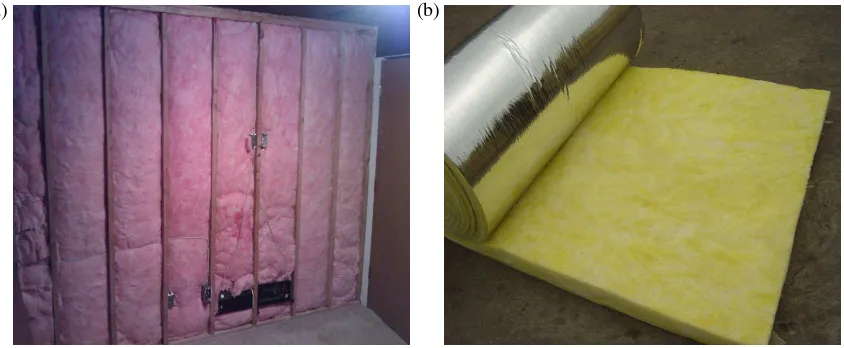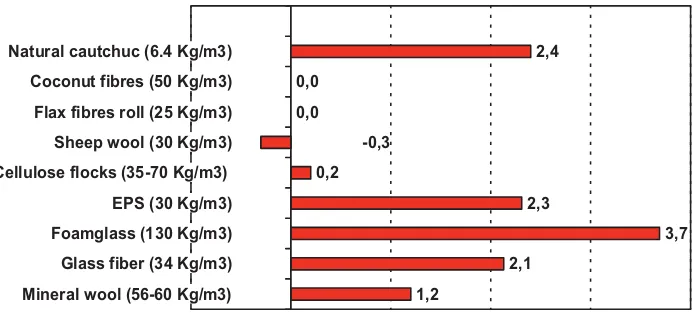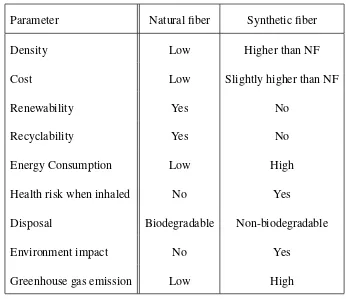Faculty of Mechanical Engineering
PADDY FIBER AS AN ALTERNATIVE SUSTAINABLE
ACOUSTIC ABSORBER MATERIAL
Yasseer bin Abdullah
Master of Science in Mechanical Engineering
PADDY FIBER AS AN ALTERNATIVE SUSTAINABLE ACOUSTIC ABSORBER MATERIAL
YASSEER BIN ABDULLAH
A thesis submitted
in fulfillment of the requirements for the degree of Master of Science in Mechanical Engineering
Faculty of Mechanical Engineering
DECLARATION
I declare that this thesis entitle ”Paddy fiber as an alternative sustainable acoustic absorber
material” is the result of my own research except as cited in the references. The thesis has
not been accepted for any degree and is not concurrently submitted in candidature of any
other degree.
Signature : ...
Name : ...
APPROVAL
I hereby declare that I have read this thesis and in my opinion this thesis is sufficient in terms
of scope and quality for the award of Master of Science in Mechanical Engineering
Signature : ...
Supervisor Name : ...
DEDICATION
ABSTRACT
The use of synthetic materials as acoustic absorbers is still applied extensively in building
industry. These non-biodegradable materials do not only cause pollution to the environment,
but also contribute significantly in increasing the CO2 causing the effect of global warming.
Therefore researchers have now driven their attentions to find sustainable and eco-friendly
materials to be an alternative sound absorber. This study discusses the use of natural waste
fibers from dried paddy as fibrous acoustic material. Since this is one of common natural
waste materials found across South East Asia, the usage will also minimize the production
cost. Samples of sound absorbers from paddy fibers were fabricated and the acoustic
proper-ties were determined through experiment. The paddy fibers are found to have good acoustic
performance with normal incidence absorption coefficient greater than 0.5 from 1 kHz and
can reach the average value of 0.8 above 2.5 kHz. The sound absorption performance can be
further increased at lower frequency range by 50% with a layer of polyester cloth added to
its front surface. The absorption coefficient result from sample with weight of 3 grams and
thickness of 20 mm is found to be comparable against that from the commercial synthetic
ABSTRAK
Penggunaan bahan-bahan sintetik sebagai penyerap bunyi masih lagi digunakan secara meluas di dalam industri pembinaan. Bahan yang tidak-terbiodegradasi ini tidak hanya akan menyebabkan punca pencemaran kepada alam sekitar, tetapi juga menyumbang kepada peningkatan CO2 yang boleh menyebabkan kesan pemanasan global. Justeru, para
ACKNOWLEDGEMENTS
In the name of Allah, The Beneficient, The Merciful
This research was made possible through contributions, support, and encouragement from
many individuals. Unfortunately, it is not possible to acknowledge each of them here. First
and foremost , I would like to thank ALLAH SWT for the blessing and ability given to me to
eventually complete my Master thesis . I would like to give sincere tribute to my supervisor,
Dr. Azma Putra for everything. From preliminary ideas to data processing, invaluable
guid-ance, continuous encouragement and excellent supervision in making this research possible.
I really appreciate the consistent support he provided me throughout the research. The good
advise, support and friendship of my second supervisor, Prof. Dr. Md Razali bin Ayob has
been invalueable on both academic and personal level for which I am extremely grateful.
I wish to express my gratitude to my parents, Hj Abdullah and Hjh Maliah, for their
un-limited love. It is because of their prayer that I have become what I am. I could not find a
appropriate words that could properly describe my appreciation for their devotion, support
and faith in pursuing my dreams. Also for my parents in law, Allahyarham Hasan and Hjh
Rossnah for their sincere kindness.
Also not to forget staff in the Faculty of Mechanical Engineering, UTeM which their names
are too numerous to mention, who help me directly or indirectly throughout the whole
project. For my colleagues in ’Acoustics and Vibration Group’, thank you for the brilliant
discussion which gives much input to my work.
Finally but most importantly, for my beloved wife, Noraini, to whom this work is lovingly
dedicated. Her unconditional love, support, encouragement and sacrifices has given me a
peaceful heart during my study. And also for her gifts from heaven, Muhammad Adam
TABLE OF CONTENTS
2.4 Factors influencing sound absorption 14
2.5 Established works on natural fiber as sound absorber 17
3 METHODOLOGY 24
3.1 Testing methods for absorption coefficient 25
3.1.1 Reverberation chamber method 25
3.1.2 Impedance tube method 26
3.2 Design of an impedance tube 27
3.2.1 Cross-section 28
3.2.2 Choosing working frequency range 28
3.2.3 Length of the impedance tube 30
3.2.4 Microphones 30
3.2.5 Test sample holder 31
3.2.6 Signal processing equipment 31
3.2.7 Loudspeaker 32
3.2.8 Signal generator 32
3.2.9 Loudspeaker termination 32
3.2.10 Thermometer and barometer 33
3.2.11 Test specimen mounting 33
3.2.12 Signal processing 34
3.3 Fabrication of impedance tube 34
3.4 Validation of impedance tube 38
3.5 Fabrication of flow resistivity instrument 42
3.6 Experimental setup for absorption coefficient test 46
3.7 Fabrication of samples 47
3.8 Density, porosity and water absorption test 49
3.8.1 Density 49
3.8.2 Porosity 51
3.8.3 Water absorption 51
3.9 Flammability test 52
3.10 Microscopic test 53
4 RESULT AND DISCUSSION 54
4.1 Measured density, porosity and water absorption 54
4.2 Flammability test result 57
4.3 Microscopic view of the sample 58
4.4 Measured absorption coefficient 58
5 CONCLUSION AND RECOMMENDATIONS FOR FUTURE RESEARCH 67
5.1 Conclusion 67
5.2 Recommendations 68
LIST OF TABLES
TABLE TITLE PAGE
1.1 Comparison between natural and man-made fibers. 4
2.1 Comparison of properties of paddy fibers (average) compared with other
nat-ural fibers. 22
3.1 Summary between two testing methods to measure absorption coefficient. 27
3.2 Relative distance of the microphones. 36
3.3 Frequency limit of measurement. 36
3.4 Equipment used in the experiment. 39
3.5 List of equipment used in the experiment. 43
3.6 Determination of airflow resistance according to ISO 29053 45
4.1 The measured density for 10 mm thick samples. 54
4.2 The measured density for 20 mm thick samples. 55
4.3 The measured porosity for different weight of samples. 55
4.4 The water absorption test results. 56
4.5 Flammability rating summary. 57
LIST OF FIGURES
FIGURE TITLE PAGE
1.1 (a) Practical noise insulations in a building and (b) glass fiber; synthetic
fibrous material common used as sound absorber. 2
1.2 Assessment on Global Warming Potential 3
2.1 Reflection, absorption and transmission of sound energy 6
2.2 (a) Schematic representation of sound propagation in a room and (b) schematic
representation of the functioning of sound barriers. 8
2.3 Typical frequency range of sound sources. 8
2.4 Types of porous absorber. 10
2.5 Ilustration of porous absorber cross section. 11
2.6 Energy transfer of particle velocity. 12
2.7 Classification of fibers 14
2.8 Paddy field after harvesting season. 21
2.9 External anatomy of paddy. 22
3.1 The flowchart of research methodology. 24
3.2 Measurement of sound absorber inside a reverberation chamber. 26
3.3 A complete system of a commercial impedance tube. 27
3.4 Different diameters of impedance tube: (a) large diameter for low frequency measurement and (b) small diameter for mid-high frequency measurement. 29
3.5 Microphone mounting 31
3.6 Layout design for sound absorption impedance tube 35
3.7 Technical drawing of the impedance tube. 35
3.8 Constructed impedance tube 37
3.9 Separated sample holder and embedded loudspeaker. 37
3.10 Diagram of measurement setup using impedance tube to measure sound
ab-sorption coefficient. 38
3.11 Test result of absorption coefficient without measurement sample. 39 3.12 The autospectrum from each microphone: (a) closest to the loudspeaker and
(b) closest to the sample. 41
3.13 Results of measurement validation using MPP having hole diameter of 0.5
mm and perforation ratio : (a) 0.5% and (b) 1.0% 41
3.18 The collected raw materials of paddy fibre. The right side shows the
materi-als cut in small pieces. 48
3.19 The mould used to construct the absorber sample. 48
3.20 Examples of fabricated samples from paddy fibers. 49
3.21 Flow chart of pre-treatment and fabrication processes. 50
3.22 Horizontal flammability test setup 52
4.1 Comparison condition between the sample under the water absorption test
and with normal sample. 56
4.2 Microscopic view of several weight of paddy fiber samples (a) 3 grams (b)
4 grams (c) 5 grams and (d) 6 grams. 59
4.3 Measured absorption coefficient of samples with the same fiber weight of
2 grams: —⇤—t= 10mm and —⌃—t= 20mm. 60
4.4 Measured absorption coefficient of samples with the same thickness, t =
20mm: —⌃— 2 grams and —4— 4 grams. 60
4.5 Measured absorption coefficient of samples with the same density, ⇢bulk =
234kg/m3
: —⇤—t = 10mm; 2 grams and —4—t= 20mm; 4 grams. 61
4.6 Measured absorption coefficient of 20 mm thick samples with different fiber weight: –⌃–2 grams, –B–3 grams, –4–4 grams, –•–5 grams, –⌅–6 grams. 62 4.7 Measured absorption coefficient of 2 gram samples with thickness of (a)
10 mm and (b) 20 mm with different backed air layer thicknesses: –⌃–
with-out air layer, –⇥–D = 10mm and –O–D= 20mm. 64
4.8 Sample of the paddy fiber attached with polyester fabric. 65
4.9 Measured absorption coefficient of sample (t = 20 mm, 2 grams) with
polyester fabric: –⌃–without, –H–on front surface, –⌅–on back surface and
–•–on front and back surfaces. 65
4.10 Comparison of absorption coefficient of the paddy fiber sample (–.–;t= 20
mm, 3 grams) with that from the commercial glass wool (− − −). 66
LIST OF ABBREVIATIONS
DAS DataAcquisitionSystem
dpf denierperfilament
EPS ExpandedPolyStyrene
FFT FastFourierTransform
GWP GlobalWarmingPotential
IRM InvertedResearchMicroscope
kHz kiloHertz
NF NaturalFiber
NWC NonWovenCloth
Pa Pascal
SF SyntheticFiber
TLF TeaLeafFiber
LIST OF SYMBOLS
A Cross-sectional area
co Speed of sound
d Diameter of the tube
Ei Incident energy
Er Reflected energy
Et Transmitted energy
f Frequency
fl Lower frequency range of the tube
fu Upper frequency range of the tube
G11 Auto-spectrum
G12 Cross-spectrum
H12 Transfer function between microphone-1 and microphone-2
j =p−1 Imaginary unit
ko Acoustic wavenumber
M Acoustic reactance
m mass per unit area of the panel sample
R Acoustic resistance
W Weight of the sample
qv Volumetric airflow rate
↵ Sound absorption coefficient
φ Porosity of porous material
λ Acoustic wavelength
⇢ Density of air
⇢b Density of sample
! Angular frequency
LIST OF PUBLICATIONS
Journal Articles
A. Putra, Y. Abdullah, W.M.F.W. Mohamad and N.L. Salleh, Biomass from paddy
waste fibers as sustainable acoustic material. Advances in Acoustics and Vibration, Vol. 2013, Article ID 605932, 7 pages (2013), doi: 10.1155/2013/605932.
A. Putra, Y. Abdullah, H. Efendy, W.M.F.W. Mohamad, M.R. Ayob and M.S. Py,
Uti-lizing sugarcane wasted fibers as sustainable acoustic absorber,Procedia Engineering, Vol. 52, pp. 632-638 (2013)
Y. Abdullah, A. Putra, H. Efendy, W.M.F.W. Mohamad and M.R. Ayob,
Investiga-tion on sound absorpInvestiga-tion coefficient of natural paddy fibers,International Journal of Renewable Energy Resources(IJRER), Vol. 3 (1), pp. 8-11 (2013).
Proceedings
Y. Abdullah, A. Putra, H. Efendy, W.M.F.W Mohamad and M.R. Ayob, The effect
of binder on the acoustical performance of the paddy straw ’green’ sound absorber.
Proceedings of 3rd International Conference on Engineering and ICT(ICEI), Melaka, Malaysia, 2012.
Y. Abdullah, A. Putra, H. Effendy and W.M.F.W. Mohamad, Investigation on natural
waste fibers from dried paddy straw as a sustainable acoustic absorber. IEEE First Conference on Clean Energy and Technology CET, Kuala Lumpur, Malaysia, 2011.
Y. Abdullah, A. Putra, H. Efendy, W.M.F.W Mohamad and M.R. Ayob, Dried Paddy
CHAPTER 1
INTRODUCTION
1.1 Background
The issue of conserving environmental condition and its relation with global warming
has attracted attention of researchers for new technologies which are more environmentally
friendly. Besides finding alternative energy to limit the use of fossil fuels and deforestation,
attemps are also directed to create products from re-cycleable and sustainable materials. The
synthetic materials especially those made from minerals have been known to have issues
concerning their pollution with regards to their disposal.
For application in building acoustics for example, where sound quality in a room such
as the theatre hall, music studio, lecture room, teleconferencing room, cinema as well as
the meeting room, classical abrasive and porous acoustic materials are still widely used.
Demands of acoustic quality in factory and warehouse should also be taken seriously to
control the noise level problem.
To increase the sound absorption, the walls in buildings are usually covered by
ab-sortive layers using glass wools or acoustic foams made from synthetic chemical substances
as seen in Figure 1.1. The room ceiling usually uses the commercial gypsum boards, made
by high technology chemical process. Moreover, the production also gives huge contribution
to CO2pollution to the atmosphere.
(a) (b)
Figure 1.1 (a) Practical noise insulations in a building (Hometheaterfan, 2011) and (b) glass fiber; synthetic fibrous material common used as sound absorber
(Anony-mous, 2011).
glass fiber are huge contributors to earth global warming. The Global Warming Potential
(GWP) chart of sound absorber panels made of natural and synthetic materials as shown
in Figure 1.2 represents the ’equivalent’ contributions of CO2 into the atmosphere from
the production of an absorber panel from ”cradle” to grave (Desarnaulds et. al., 2005). It
can be seen that the synthetic-based fibers for example foamglass, contributes high GWP if
compared to natural-based fibers for example coconut fibers. Therefore, instead of using the
synthetic mineral fibers, researches are directed to find natural fibers as an alternative choice
to be developed as sound absorbers. The natural fibers offer some advantages including
renewable, biodegradable and cause much less harm to human health. Table 1.1 summarises
the advantages of natural fiber compared with the synthetic fibers (Wambuaet. al., 2003).
1.2 Problem Statement
nat-1,2 Cellulose flocks (35-70 Kg/m3) Sheep wool (30 Kg/m3) Flax fibres roll (25 Kg/m3) Coconut fibres (50 Kg/m3) Natural cautchuc (6.4 Kg/m3)
GWP Global Warming Potential Kg CO2 eq.
Figure 1.2 Assessment on Global Warming Potential (Desarnauldset. al., 2005)
contribution of CO2release in the atmosphere. The abundance biomass source of this natural
fiber is potential to be employed as raw materials for sound absorber panels. Investigation
on the ability of the paddy fiber as an acoustic absorber material is therefore of interest.
1.3 Objectives
This study embarks on the following objectives:
1. To fabricate impedance tube and flow resistivity device.
2. To fabricate samples of acoustic absorber from paddy fiber.
3. To determine the acoustic properties of paddy fiber through experiment.
4. To measure the physical properties of paddy fiber.
Table 1.1 Comparison between natural and man-made fibers (Wambuaet. al., 2003).
Parameter Natural fiber Synthetic fiber
Density Low Higher than NF
Cost Low Slightly higher than NF
Renewability Yes No
Recyclability Yes No
Energy Consumption Low High
Health risk when inhaled No Yes
Disposal Biodegradable Non-biodegradable
Environment impact No Yes
Greenhouse gas emission Low High
trend of the absorption coefficient can be concluded for other properties. This study therefore
limits to the following scopes:
1. Samples of the absorber were made for thickness of 10 mm and 20 mm and were
limited to weight of 2 grams until 6 grams.
2. Experiment of absorption coefficient was done using impedance tube and thus
repre-sents only the absorption performance for normal incidence of sound.
3. The physical test includes the density, porosity, microscopic, water absorption and
1.5 Thesis Layout
This thesis consists of five chapters. Chapter 1 discusses the problem definition,
jus-tification for carrying out the research (background study), objective and the scope of the
project.
Chapter 2 briefs a description of fundamental theories of sound absorption. General
review on natural fiber properties and some of the previous researches on the natural waste
fibers are presented. Natural fiber properties and characteristic of paddy are also reviewed.
Chapter 3 are the details explanation of the methodology of the research. Development
and fabrication of instruments used for acoustic properties measurement, namely impedance
tube and flow resistivity instrument are presented in this chapter. This also includes the
phys-ical property tests, i.e. the density, porosity, water absorption tests as well as the flammability
and microscopic tests.
Chapter 4 discusses the results and analysis in details which are the core part of this
thesis, particularly for the measured absorption coefficent. The conclusion is written in
CHAPTER 2
LITERATURE REVIEW
In this chapter, brief principle of sound absorption and porous absorbers are explained. The
properties of general fibers are also described. Established works on sound absorbers from
natural materials are reviewed followed by paddy fibers history.
2.1 Sound Absorption
Consider an acoustic material which is uniform and unbounded immersed in air and is
impinged by a sound wave. Besides reflected and absorbed, the energy is also transmitted to
other side of the material as illustrated in Figure 2.1.
Incident, Ei
Reflected, Er Transmitted, Et
Absorbed, Ea
Figure 2.1 Reflection, absorption and transmission of sound energy
Ei =Er+Ea+Et (2.1)
whereEi is the incident energy,Er is the reflected energy,Ea is the absorbed energy
andEtis the transmitted energy.
The sound absorption coefficient simply indicates the portion of the sound energy
ab-sorbed by the material from the total energy of the incoming wave expressed by
↵ = Ei−Er
Ei = 1−
Er
Ei = 1−r (2.2)
wherer is the power reflection coefficient. From Eq.(2.1),Ei -Er= Ea+Et i.e. the
sound energy absorbed by the system (seen from incident field) includes the transmission
into the other side of the material. If the material is attached on to a rigid surface, thenEt
= 0. Whenever the material impedance is equal to the characteristic impedance of the air
(medium), maximum sound absorption occurs. Therefore, the amount of the energy being
absorbed depends on the material impedance which is determined by the acoustic properties
of the material such as porosity, tortuosity and flow resistivity. The absorption varies with
frequency as well as with angle of incidence of the sound waves (Everest and Shaw, 2001).
To optimise the acoustics in a rooms, among other techniques is to interrupt the paths
of sound propagation towards listener as seen in Figure 2.2. Apart from direct sound, sound
is transmitted by reflections from the walls and the ceiling. Depending on the sound




